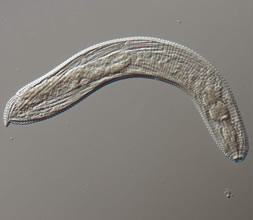Nematodes (Nematoda)
In this section
 More intensive taxonomic study of nematodes started in the early 1960s covering, over the next decades, free-living, plant-parasitic and insect-parasitic nematode groups. The first collation of published records from the specialist disciplines of plant nematology, animal helminthology, marine biology, soil zoology, and invertebrate pathology was for the “Species 2000” initiative. Dr G W Yeates’ preliminary, partial assessment was of a known fauna of some 631 species.
More intensive taxonomic study of nematodes started in the early 1960s covering, over the next decades, free-living, plant-parasitic and insect-parasitic nematode groups. The first collation of published records from the specialist disciplines of plant nematology, animal helminthology, marine biology, soil zoology, and invertebrate pathology was for the “Species 2000” initiative. Dr G W Yeates’ preliminary, partial assessment was of a known fauna of some 631 species.
The first records of nematodes of economic importance in New Zealand appeared late in the 19th century (Kirk 1899; Thomson 1922), freshwater species were first described in 1904 (Cobb 1904), and marine nematodes described in 1921 (Ditlevsen 1921). However, systematic research has been sporadic, and only about 647 species (those in “Species 2000” plus Wouts’ Criconematina in Fauna of New Zealand 55) are currently known from the region.
Apart from the nematodes of plants and introduced mammals that have been studied for their perceived economic and public health impacts, the New Zealand nematode fauna is as poorly known as that of most Southern Hemisphere countries. There are tantalising biogeographic links but too few data. Given the present limited knowledge, it is not possible to draw the biogeographic relationships of the nematode fauna of the New Zealand region (see “Species 2000”).
The nematode project studies on the family Tripylidae Oerley, 1880, mainly focused on the genera Tripyla Bastian, 1865; Tobrilus Andrássy, 1959 and Trischistoma Cobb, 1913. Also some nematodes in the family of Alaimidae Micoletzky, 1922.
The nematodes in the families Tripylidae and Alaimidae mainly occur in freshwater and soil. There are probably 20 to 40 species in New Zealand (G W Yeates pers. comm. 2007). They are generally relatively large nematodes. Their description would be a significant contribution to the known nematode fauna of New Zealand.
Publications
Yeates GW, Buckley TR 2009. First records of mermithid nematodes (Nematoda: Mermithidae) parasitising stick insects (Insecta: Phasmatodea). New Zealand journal of zoology 36(1): 35–39. ISI:000265621700005
Yeates GW, Ferris H, Moens T, Putten WHvd 2009. The role of nematodes in ecosystems. In: Wilson MJ, Kakouli-Duarte T ed. Nematodes as environmental indicators. Wallingford UK, Cabi. Pp. 1–44.CABI:20093184807
Zhao ZQ, Riley R, Davies KA, Li DM 2009. Above-ground nematodes of conifers in south-eastern Australia. Transactions of the Royal Society of South Australia 133(1): 41–50.
Mercer CF, Bell NL, Yeates GW 2008. Plant-parasitic nematodes on pasture in New Zealand. Australasian plant pathology 37(3): 279–288.
Yeates GW, Skipp RA, Chen LY, Waghorn TS, Potter JF 2007. Temporal and spatial aspects of the influence on soil nematodes of depositing artificial pats of sheep faeces containing a range of parasite management agents. Applied soil ecology 37(1-2): 106–117.
Yeates G, Pattison T 2006. Moving up within the food web: Protozoa and Nematodes. In: Uphoff N, Ball AS, Fernandes E, Herren H, Husson O, Laing M, Palm C, Pretty J, Sanchez P, Sanginga N and others ed. Biological approaches to sustainable soil systems. Books in Soils, Plants, and the Environment no. 113. 10. Boca Raton, CRC Press. Pp. 149–161
Yeates G 2005. Bringing the public to nematodes. Nematology newsletter 51(2): 3–.
Moens T, Yeates GW, de Ley P 2004. Use of carbon and energy sources by nematodes. Nematology monographs and perspectives 2: 529–545.
Yeates GW 2003/4. Nematodes as soil indicators: functional and biodiversity aspects. Biology and fertility of soils 37(4): 199–210.
Skipp RA, Yeates GW, Chen LY, Glare TR 2002/9. Occurrence, morphological characteristics and ribotyping of New Zealand isolates of Duddingtonia flagrans, a candidate for biocontrol of animal parasitic nematodes. New Zealand journal of agricultural research 45(3): 187–196.
Yeates GW, Dando JL, Shepherd TG 2002/9. Pressure plate studies-to determine how moisture affects access of bacterial-feeding nematodes to food in soil. European journal of soil science 53(3): 355–365.
Yeates GW, Boag B 2002. Post-embryonic growth of longidorid nematodes. Nematology 4(8): 883–889.
Yeates GW, Dimander S-O, Waller PJ, Höglund J 2002. Environmental impact on soil nematodes following the use of the ivermectin sustained-release bolus or the nematophagous fungus Duddingtonia flagrans to control nematode parasites of cattle in Sweden. Acta Agriculturae Scandinavica.Section A, Animal Science 52(4): 233–242.
Yeates GW 2001. Free-living nematodes. In: Maloy OC, Murray TD ed. Encyclopedia of plant pathology : Volume 2. New York, John Wiley. Pp. 469–470






